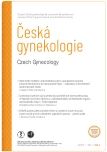Complete androgen insensitivity syndrome – rare case of malignancy of dysgenetic gonads
Authors:
V. Gamcová 1
; J. Eim 1
; I. Meixnerová 2
; R. Hudeček 2
Authors‘ workplace:
Gynekologicko-porodnické oddělení, Nemocnice Vyškov, p. o.
1; Gynekologicko-porodnická klinika LF MU a FN Brno
2
Published in:
Ceska Gynekol 2022; 87(3): 184-187
Category:
Case Report
doi:
https://doi.org/10.48095/cccg2022184
Overview
Objective: A case report of a young patient with primary amenorrhea who was diagnosed with agenesis of the uterus and was genetically confirmed for complete androgen insensitivity syndrome with already developed malignancy of dysgenetic gonads. Case report: The 17-year-old patient visited a gynecological clinic for primary amenorrhea. Both ultrasound and vaginal examination revealed suspicion of uterine agenesis, which was subsequently verified during diagnostic laparoscopy. Genetic testing showed karyotype 46,XY, and a rare diagnosis – complete androgen insensitivity syndrome. A secondary finding from a left gonadal biopsy was a Sertoli-Leydig cell tumor. The patient underwent bilateral gonadectomy and was given estrogen replacement therapy. She is now regularly examined by a pediatric oncologist. Conclusion: Complete androgen insensitivity syndrome is a rare genetic disease characterized by varying degrees of feminization in individuals with a male karyotype. It should not be neglected, especially in the differential diagnostic work-up of primary amenorrhea. Genetic testing of the karyotype should be performed whenever uterine agenesis is suspected.
Keywords:
androgen insensitivity syndrome – testicular feminization syndrome – androgen receptor – primary amenorrhea – Sertoli-Leydig cell tumor
Sources
1. Gottlieb B, Trifiro MA. Androgen insensitivity syndrome. GeneReviews, 2017 [online]. Available from: https:/ / www.ncbi.nlm.nih. gov/ books/ NBK1429/ .
2. Khollová S, Hrdonková E, Pomahačová R. Syndrom ú plné androgenní insenzitivity – kazuistika. Ceska Gynekol 2014; 79(1): 38–42.
3. Boehmer AL, Brinkmann O, Brü ggenwirth H et al. Genotype versus phenotype in families with androgen insensitivity syndrome. J Clin Endocrinol Metab 2001; 86(9): 4151–4160. doi: 10.1210/ jcem.86.9.7825.
4. Chmel R Jr, Pastor Z, Mužík M et al. Syndrom Mayer-Rokitansky-Küster-Hauser – agene ze dělohy a pochvy: aktuální znalosti a terapeutické možnosti. Ceska Gynekol 2019; 84(5): 386–392.
5. Looijenga LH, Hersmus R, Oosterhuis JW et al. Tumor risk in disorders of sex development (DSD). Best Pract Res Clin Endocrinol Metab 2007; 21(3): 480–495.
6. Batista RL, Costa EM, de Santi Rodrigues A et al. Androgen insensitivity syndrome: a review. Arch Endocrinol Metab 2018; 62(2): 227–235. doi: 10.20945/ 2359-3997000000031.
7. Patel V, Casey RK, Gomez-Lobo V. Timing of gonadectomy in patients with complete androgen insensitivity syndrome-current recommendations and future directions. J Pediatr Adolesc Gynecol 2016; 29(4): 320–325. doi: 10.1016/ j. jpag.2015.03.01.
8. Plevova P, Gerzova H. Vzácné pediatrické ovariální tumory a jejich genetické příčiny. Klin Onkol 2019; 32 (Suppl 2): S79–S91. doi: 10.14735/ amko2019S79.
9. Birnbaum W, Marshall L, Werner R et al. Oestrogen versus androgen in hormone-replacement therapy for complete androgen insensitivity syndrome: a multicentre, randomised, double-dummy, double-blind crossover trial. Lancet Diabetes Endocrinol 2018; 6(10): 771–780. doi: 10.1016/ S2213-8587(18)30 197-9.
10. Hořejší J, Kosová H a kol. Dětská gynekologie. 2. vyd. Praha: Mladá fronta 2019: 243–245.
Labels
Paediatric gynaecology Gynaecology and obstetrics Reproduction medicineArticle was published in
Czech Gynaecology

2022 Issue 3
Most read in this issue
- Cesarean scar pregnancy
- Hydronephrosis as a symptom of clinically silent ureteral endometriosis
- Ovarian tumors and genetic predisposition
- Complete androgen insensitivity syndrome – rare case of malignancy of dysgenetic gonads
